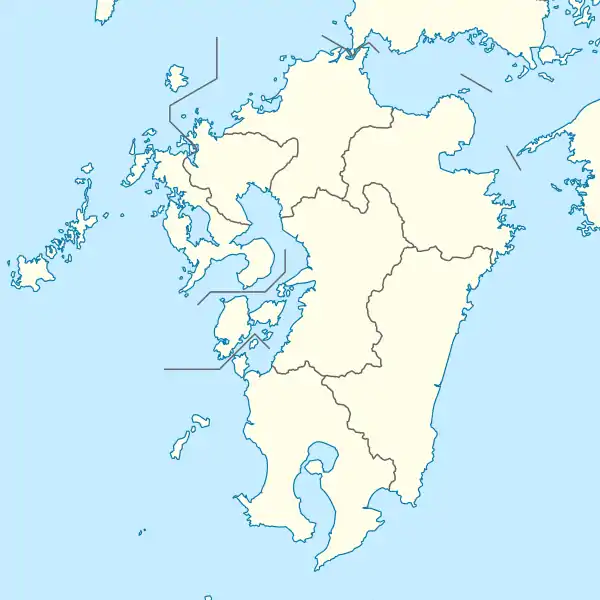1968 Hyūga-nada earthquake
The 1968 Hyūga-nada earthquake (Japanese: 1968年日向灘地震) occurred on April 1 at 09:42 local time. The earthquake had a magnitude of Mw 7.5, and the epicenter was located in Hyūga-nada Sea, off the islands of Kyushu and Shikoku, Japan. The magnitude of this earthquake was also given as MJMA 7.5.[3] A tsunami was observed.[4] One person was killed, and 22 people were reported injured.[2][5] The intensity reached shindo 5 in Miyazaki and Kōchi.
    | |
| UTC time | 1968-04-01 00:42:07 |
|---|---|
| ISC event | 823387 |
| USGS-ANSS | ComCat |
| Local date | April 1, 1968 |
| Local time | 09:42:07 |
| Magnitude | 7.5 Mw[1] |
| Depth | 30 km [1] |
| Epicenter | 32.45°N 132.27°E [1] |
| Areas affected | Japan |
| Max. intensity | JMA 5− –JMA 5+ [2] VII (Very strong)[2] |
| Tsunami | Yes |
| Casualties | 1 dead, 22 injured |
Description
This was an interplate earthquake between the Eurasian Plate and the Philippine Sea Plate. In this region, the Philippine Sea Plate is subducting beneath the Eurasian Plate. The subduction interface around this region passes southwestwards from the Nankai megathrust to the Ryukyu Trench just south of Kyusyu.[6]
This earthquake is the strongest event recorded in the Hyūga-nada Sea region. The maximum slip was estimated to be 4 m.[7] It was estimated that, in the Hyūga-nada Sea region, earthquakes with magnitudes about 7.6 occur with a period of about 200 years, while earthquakes with magnitudes about 7.1 occur with a period of about 20 to 27 years.[8] It has been pointed out that there is a tendency of occurrence of inland earthquakes in Kyushu before and after large interplate earthquakes in the Hyūga-nada Sea region.[9]
References
- ISC (19 January 2015), ISC-GEM Global Instrumental Earthquake Catalogue (1900–2009), Version 2.0, International Seismological Centre
- National Geophysical Data Center / World Data Service (NGDC/WDS) (1972), Significant Earthquake Database (Data Set), National Geophysical Data Center, NOAA, doi:10.7289/V5TD9V7K
- Yagi, Yuji; Kikuchi, Masayuki (2003), "Partitioning between seismogenic and aseismic slip as highlighted from slow slip events in Hyuga-nada, Japan", Geophysical Research Letters, 30 (2): 1087, Bibcode:2003GeoRL..30.1087Y, doi:10.1029/2002GL015664
- Geist, Eric L (2002), "Complex earthquake rupture and local tsunamis" (PDF), Journal of Geophysical Research, 107 (B5): 2086, Bibcode:2002JGRB..107.2086G, doi:10.1029/2000JB000139
- "高知県の地震活動の特徴". www.jishin.go.jp. 地震調査研究推進本部. Archived from the original on 2011-03-23.
- Asano, Y.; Obara, K.; Matsuzawa, T.; Hirose, H.; Ito, Y. (2015). "Possible shallow slow slip events in Hyuga‐nada, Nankai subduction zone, inferred from migration of very low frequency earthquakes". Geophysical Research Letters. 42 (2): 331–338. Bibcode:2015GeoRL..42..331A. doi:10.1002/2014GL062165. S2CID 130121891.
- Yagi, Yuji; Kikuchi, Masayuki; Yoshida, Shingo; Yamanaka, Yoshiko (1998). "Source Process of the Hyuga-nada Earthquake of April 1, 1968 (MJMA 7.5), and its Relationship to the Subsequent Seismicity". Zisin. 51 (1): 139–148. doi:10.4294/zisin1948.51.1_139. INIST:1588209.
- "日向灘". www.jishin.go.jp.
- "Archived copy" (PDF). Archived from the original (PDF) on 2011-07-20. Retrieved 2011-04-02.
{{cite web}}: CS1 maint: archived copy as title (link)
External links
- The International Seismological Centre has a bibliography and/or authoritative data for this event.